Significado , origen y beneficios de los maravillosos mandalas / Meaning , origin and benefits of the wonderful mandalas /

Hace días que tenia unas ganas inmensas de colorear mandalas. La mayoría de las veces estoy rodeada de niños y niñas, ya que esa es mi labor, soy profesora de telas aceobaticas y de yoga aereo para niños. Hace par de años hice un taller de mandalas , el cuál me fascinó y por alguna razón había olvidado lo gratificante que es colorear y reconectar con el subconsciente y con el mundo interior. Una tarde en que termine de impartir mi clase, observé un niño coloreando dibujos en un cuaderno, en seguida lo intérprete como una señal de que tal vez mi niña interior y mi alma necesitaban eso. Desde entonces, pasaron días y días, no me podía quitar esa imagen del niño sentado coloreando en su mesa, tan en calma y tan tranquilo. Mi alma o quizá mi niña interior ha estado manifestando sus deseos y haciéndose sentir, y les preste atención y fui a una librería a comprar dos cuadernos de dibujos de mandalas, uno me lo regale a mi misma y el otro se lo regale a mi mamá, ya que también le gusta colorear mandalas. Por un momento pensé en hacer los mandalas yo misma, pero eso retardaría un poco mi necesidad repentina e impulsiva de colorear. El primer mandala fue el más difícil de colorear, no porque me costará tomar los colores si no debido al hecho de tener que estar en quietud, sola conmigo misma y mis pensamientos, escuchando mi dialogo interno que no siempre es amable y positivo. Algunas veces los pensamientos pueden resultar agobiantes pero luego de un rato que seguí coloreando todos esos pensamientos un tanto negativos se disiparon. La vida está llena de altibajos y muchas veces necesitamos un espacio donde podamos desahogarnos y expresar las experiencias difíciles. Para ello, podemos hablar con alguien de confianza o escribir cómo nos sentimos pero, si no nos apetece, también podemos expresarnos a través de los mandalas. Este arte es una excelente herramienta para aceptar, expresar y transformar nuestros estados emocionales difíciles de procesar. De hecho, resulta un medio bastante útil para gestionar aquellos afectos que se encuentran en un nivel más inconsciente.
For days I had an immense desire to color mandalas. Most of the time I am surrounded by boys and girls, since that is my job, I am a teacher of aceobatic fabrics and aerial yoga for children. A couple of years ago I did a mandala workshop, which fascinated me and for some reason I had forgotten how rewarding it is to color and reconnect with the subconscious and with the inner world. One afternoon when I finished teaching my class, I observed a child coloring pictures in a notebook, I immediately interpreted it as a sign that perhaps my inner child and my soul needed that. Since then, days and days have passed, I couldn't get rid of that image of the boy sitting coloring at his table, so calm and calm. My soul or perhaps my inner child has been expressing her desires and making herself felt, and I paid attention to them and I went to a bookstore to buy two mandala sketchbooks, one I gave it to myself and the other I gave it to my mom , since he also likes to color mandalas. For a moment I thought about making the mandalas myself, but that would slow down my sudden and impulsive need to color a bit. The first mandala was the most difficult to color, not because it would be difficult for me to take the colors but due to the fact that I have to be still, alone with myself and my thoughts, listening to my internal dialogue that is not always friendly and positive. Sometimes the thoughts can be overwhelming but after a while that I kept coloring all those somewhat negative thoughts they dissipated. Life is full of ups and downs and many times we need a space where we can vent and express difficult experiences. To do this, we can talk to someone we trust or write how we feel, but if we don't feel like it, we can also express ourselves through mandalas. This art is an excellent tool to accept, express and transform our difficult to process emotional states. In fact, it is a very useful means to manage those affects that are on a more unconscious level.
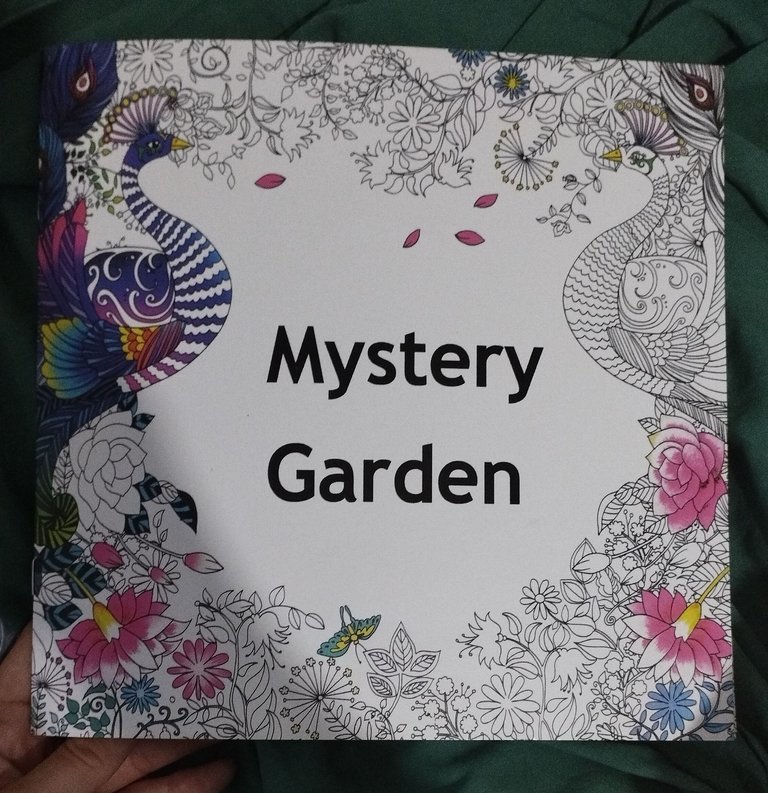
La palabra “mandala” proviene del sáncrito (lengua indoeuropea) que traducido al castellano significa “círculo sagrado” o “círculo energético”. Esta palabra está compuesta en dos partes, cada una con su respectivo significado, la primera parte que es Manda significa “esencia” y La significa “concreción”, por lo que uniendo ambas puede traducirse como “concreción de la esencia” y se dice que esto ocurre cuando creamos un mandala. El mandala es el paradigma de la evolución y la involución cósmica en su retorno al centro del universo; pero simboliza también el refluir de la experiencia de la psiquis en busca de la unidad de consciencia para descubrir el principio ideal de las cosas. No es solamente un cosmograma sino también un psicograma, el esquema de la desintegración del uno en lo múltiple y la reintegración de lo múltiple en el uno, en la consciencia absoluta, entera y luminosa, que tendria que brillar en lo profundo de nuestro ser. El hombre tene en el centro de sí mismo el principio recóndito de su propia vida, la esencia misteriosa, el punto luminoso de consciencia del que irradian las facultades psiguicas. El tiene la vaga intuición de esa luz que podría brillar dentro de sí, expandiéndose y propagándose hacia planos espintuales.
The word "mandala" comes from Sanskrit (Indo-European language) which translated into Spanish means "sacred circle" or "energy circle". This word is composed of two parts, each one with its respective meaning, the first part that is Manda means "essence" and La means "concretion", so joining both can be translated as "concretion of the essence" and it is said that this occurs when we create a mandala. The mandala is the paradigm of evolution and cosmic involution in its return to the center of the universe; but it also symbolizes the reflux of the experience of the psyche in search of the unity of consciousness to discover the ideal principle of things. It is not only a cosmogram but also a psychogram, the scheme of the disintegration of the one in the multiple and the reintegration of the multiple in the one, in the absolute, entire and luminous consciousness that should shine in the depths of our being. Man has in the center of himself the hidden principle of his own life, the mysterious essence, the luminous point of consciousness from which psychic faculties radiate. He has a vague intuition of that light that could shine within himself, expanding and propagating towards spiritual planes.
Un poco de historia acerca de los mandalas:
A little history about mandalas:
Esta palabra tiene su origen en India y se refiere básicamente a aquellas imágenes circulares que comienzan a partir de un eje central, seguidos de una diversa cantidad de figuras simétricas entre sí que están dirigidas hacia los cuatro puntos cardinales. Realmente, no existe algún patrón para hacer este tipo de dibujo ya que su diseño es libre siempre y cuando cumpla con las características básicas para que sea considerado como tal (figura circular, parte de un eje central, figuras simétricas entre sí, figuras dirigidas hacia los cuatro puntos cardinales). Se dice que la forma circular característica de los mandalas proviene desde temprano en la historia de la humanidad y de hecho se han encontrado este tipo de formas bajorrelieves dibujados sobre rocas con diseños muy parecidos en otras partes del mundo como en Europa, América del norte, África, China, la India y Australia así que realmente no solo han sido realizados por los hindúes.
This word originates from India and basically refers to those circular images that start from a central axis, followed by a diverse number of symmetrical figures that are directed towards the four cardinal points. Actually, there is no pattern to make this type of drawing since its design is free as long as it meets the basic characteristics for it to be considered as such (circular figure, part of a central axis, figures symmetrical to each other, figures directed towards the four cardinal points). It is said that the characteristic circular shape of the mandalas comes from early in the history of humanity and in fact this type of bas-relief shapes drawn on rocks with very similar designs have been found in other parts of the world such as Europe, North America, Africa, China, India and Australia so it really hasn't just been done by the Hindus.
Los budistas lo utilizan básicamente como una herramienta para practicar la meditación. Sin embargo también tiene fines espirituales y curativos ya que se dice que el diseño del mandala (debido a que se desarrolló desde muy temprano en la historia de la humanidad y a su diseño que es parecido a la estructura del cosmos y de todo lo que nos rodea) está grabado en lo profundo de nuestro inconsciente.
Buddhists basically use it as a tool to practice meditation. However, it also has spiritual and healing purposes since it is said that the design of the mandala (due to the fact that it was developed very early in the history of humanity and its design that is similar to the structure of the cosmos and everything that surrounds us ) is engraved deep in our unconscious.
Los mandalas fueron estudiadas por el psiquiatra Carl Gustav Jung, quien los tomó como expresiones probables de lo inconsciente colectivo. Jung analizó que a través de la creación de mandalas el sujeto puede perfeccionar su proceso de individuación. Gracias a sus resultados positivos, los mandalas han sido incluidas en los aspectos educativos, en instituciones que trabajan con personas con problemas emocionales. Nancy A. Curry y Tim Kaser (2005).
The mandalas were studied by the psychiatrist Carl Gustav Jung, who took them as probable expressions of the collective unconscious. Jung analyzed that through the creation of mandalas the subject can perfect his individuation process. Thanks to his positive results, mandalas have been included in educational aspects, in institutions that work with people with emotional problems. Nancy A. Curry and Tim Kaser (2005)
"En sus Memorias, Jung cuenta que durante la Primera Guerra Mundial, siendo comandante de un campamento de prisioneros en Suiza, empezó a dibujar cada mañana un mandala que - según él - reflejaba su estado de ánimo interno. Era como una radiografía de su psiquis. En ella iba observando cambios sutiles en su crecimiento personal. Era como si fuera armonizándose en torno a un núcleo, un punto central, un centro magnético que lo iba conduciendo hacia una paulatina integración. En aquel punto central estaban condensadas todas sus posibilidades, esperando desplegarse para llegar a un desarrollo pleno y armonioso, tal como un director de orquesta da vida a lo escrito en un lenguaje cifrado. Al principio, comprendia muy poco lo que esto significaba, pero gradualmente fue dándose cuenta que estaba temiendo una experiencia extraordinariamente significante: aquellos dibujos eran informes diarios sobre el trabajo interno que ese punto central estaba efectuando en él. Comprendió que la meta del desarrollo del individuo es su Ser, que su evolución no es lineal sino en espiral, en una circunvalación ascendente que se va acercando cada vez más al centro y cúspide de esa espiral. Continuó investigando y dibujando mandalas, sobre todo cuando en su práctica como psiquiatra empezó a ver que sus pacientes hacian dibujos espontáneos que iban evolucionando a medida que avanzaban en lo que él llamó «proceso de individuación». Esos dibujos iban siendo cada vez más definidos y más armónicos durante este periodo. Algunos aparecian en los sueños de los pacientes y ellos los dibujaban para hacer más explicito el relato de su sueño."
"In his Memoirs, Jung recounts that during the First World War, as commander of a prison camp in Switzerland, he began to draw a mandala every morning that - according to him - reflected his internal state of mind. It was like an X-ray of his psyche. In it he was observing subtle changes in his personal growth. It was as if he were harmonizing around a nucleus, a central point, a magnetic center that was leading him towards a gradual integration. In that central point all his possibilities were condensed, waiting to unfold into full and harmonious development, just as a conductor brings to life what is written in a coded language.At first, he understood very little what this meant, but gradually he realized that he was dreading an extraordinarily significant experience. : Those drawings were daily reports on the internal work that this central point was carrying out in him. He understood that the goal of the development of the individual is his Being, that his evolution is not linear but in a spiral, in an ascending circumvallation that gets closer every time. once more to the center and top of that spiral. He continued researching and drawing mandalas, especially when in his practice as a psychiatrist he began to see that his patients made spontaneous drawings that evolved as they progressed in what he called the "individuation process." Those drawings were becoming more defined and more harmonious during this period. Some appeared in the dreams of the patients and they drew them to make the story of their dream more explicit."
Saalas Jarre
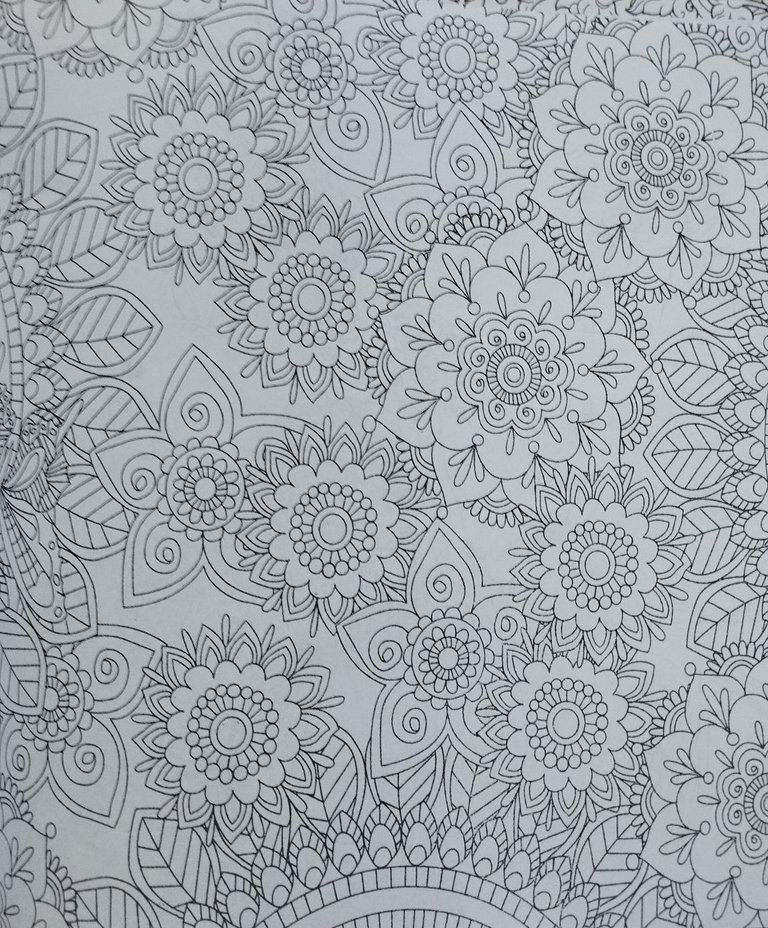
Algunos beneficios de los mandalas:
Some benefits of mandalas:
- Diseñar y colorear mandalas ayuda a focalizar la atención, por lo tanto son un excelente ejercicio para calmar la sensación de estrés y despejar nuestra mente. De hecho, los mandalas están diseñados para que nos liberemos de las preocupaciones porque favorecen la concentración en el presente, razón por la cual son una potente herramienta de relajación.
- Designing and coloring mandalas helps to focus attention, therefore they are an excellent exercise to calm the feeling of stress and clear our mind. In fact, mandalas are designed to free us from worries because they promote concentration in the present, which is why they are a powerful relaxation tool.
- Los mandalas facilitan que nos conectemos con lo más íntimo de nosotros, propiciando así el autoconocimiento. Son un maravilloso ejercicio de reflexión sobre nuestro lugar en el mundo y la relación que tenemos con los demás. Estas representaciones artísticas propician que nos enlacemos con las fuerzas más profundas de nosotros y del universo, a través de las energías que fluyen con cada forma y color.
- Mandalas make it easier for us to connect with the most intimate of us, thus promoting self-knowledge. They are a wonderful exercise in reflection on our place in the world and the relationship we have with others. These artistic representations encourage us to connect with the deepest forces of ourselves and the universe, through the energies that flow with each shape and color.
- Conecta con tu niño interior. Colorear es una actividad que solemos relacionar con la infancia. A medida que nos hacemos adultos apartamos los lápices de colores y rotuladores, salvo para subrayar apuntes o informes. Sin embargo, este pasatiempo puede resultar muy beneficioso no solo porque genere bienestar y tranquilidad, sino porque también estimula distintas áreas cerebrales relacionadas con los sentidos y la creatividad.
- Connect with your inner child. Coloring is an activity that we usually associate with childhood. As we become adults, we put away colored pencils and markers, except to underline notes or reports. However, this pastime can be very beneficial, not only because it generates well-being and tranquility, but also because it stimulates different brain areas related to the senses and creativity.
- Creatividad. Cuando te adentras en el dibujo de los mandalas tu cerebro comienza a buscar inspiración, formas y patrones en el mundo que te rodea. Tu creatividad empieza a fluir y desarrollarse. Son un fantástico ejercicio para ejercitarla.
- Creativity. When you get into the drawing of mandalas your brain begins to look for inspiration, shapes and patterns in the world around you. Your creativity begins to flow and develop. They are a fantastic exercise to exercise her.
- Equilibrio: activa en profundidad y a todos los niveles nuestro cerebro produciendo un estado general de bienestar y satisfacción y permitiendo un equilibrio entre cuerpo y mente.
- Balance: activates our brain in depth and at all levels, producing a general state of well-being and satisfaction and allowing a balance between body and mind.
Cada persona, según sus circunstancias, vivirá con estos dibujos una experiencia única y se nutrirán de sus características de forma diferente.
Each person, according to their circumstances, will live a unique experience with these drawings and they will be nourished by their characteristics in a different way.
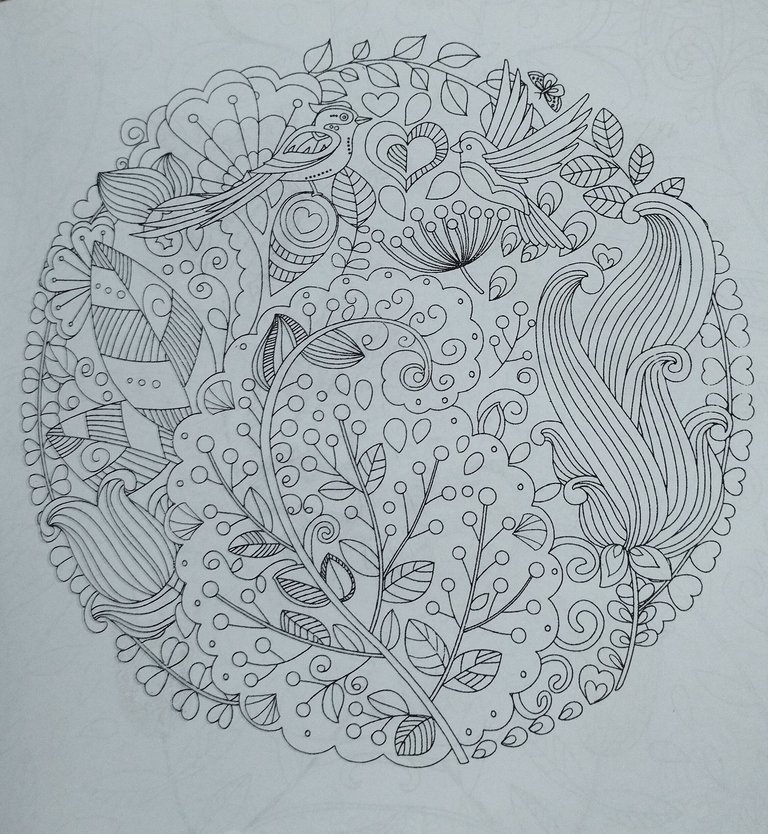
Significado de los colores en los mandalas:
Meaning of colors in mandalas:
Rojo. Pasión, sensualidad, fuerza, poder y agresividad. Primer chakra.
Naranja. Placer, gloria, vanidad, progreso y energía. Segundo chakra.
Amarillo. Alegría, voluntad y novedad. Tercer chakra.
Verde. Esperanza, desenfado y naturaleza. Cuarto chakra.
Azul. Tranquilidad, seriedad, respeto y comunicación. Quinto chakra.
Violeta. Meditación, creatividad y oscilación. Sexto chakra.
Blanco. Paz, armonía, bondad, delicadeza y timidez. Séptimo chakra.
Negro. Profundidad, misterio, autoridad, dignidad, seguridad, tristeza y luto.
Red. Passion, sensuality, strength, power and aggressiveness. First chakra.
Orange. Pleasure, glory, vanity, progress and energy. Second chakra.
Yellow. Joy, will and novelty. Third chakra.
Green. Hope, ease and nature. Fourth chakra.
Blue. Tranquility, seriousness, respect and communication. Fifth chakra.
Violet. Meditation, creativity and oscillation. sixth chakra.
White. Peace, harmony, kindness, delicacy and shyness. seventh chakra.
Black. Depth, mystery, authority, dignity, security, sadness and mourning.
Significado de algunas de las figuras geométricas en los mandalas:
Meaning of some of the geometric figures in the mandalas:
Triángulo: se refiere a la vitalidad, la energía y la transformación. Tiene relación con el agua.
Cuadrado: equilibrio, estabilidad.
Cruz: se relaciona con nuestras propias decisiones y las direcciones hacia donde nos puede dirigir cada una de ellas. Implica cambios.
Estrella: estar en positivo, ser optimista y tener deseo por el éxito y salir adelante.
Espiral: vitalidad, flujo de energía o por el contrario confusión mental del dibujante.
Corazón: unión, amistad, felicidad.
Laberinto: confusión, necesidad de autococimiento y búsqueda interior.
Mariposa: transformación y muerte.
Pentágono: silueta del ser humano y elementos de la tierra.
Hexágono: equilibrio.
Circle: the absolute, the true self, the essence of being, self-confidence. It can also mean distance and extension.
Triangle: refers to vitality, energy and transformation. It is related to water.
Square: balance, stability.
Cross: it is related to our own decisions and the directions in which each of them can lead us. It implies changes.
Star: be positive, optimistic and have a desire for success and get ahead.
Spiral: vitality, flow of energy or, on the contrary, mental confusion of the cartoonist.
Heart: union, friendship, happiness.
Labyrinth: confusion, need for self-knowledge and inner search.
Butterfly: transformation and death.
Pentagon: silhouette of the human being and elements of the earth.
Hexagon: balance.

A continuación, este fue el mándala que coloree en el cuaderno de dibujos que me regalé, no le tome fotos al inicio pero si a la mitad del proceso. Cómo dije anteriormente, cuando comencé a colorear no lograba mantenerme en calma , ni tranquila, más bien me daba mucha ansiedad. A medida que iba coloreando y pasaba más tiempo coloreando el mándala me fui calmando. Y mis pensamientos se fueron apaciguando. De todas formas, es un hábito que uno tiene que crear, y seguir buscando estar en quietud y meditación. Ha Sido una experiencia hermosa.
Next, this was the mandala that I colored in the sketchbook that I gave myself, I did not take photos at the beginning but I did take photos halfway through the process. As I said before, when I started coloring I couldn't stay calm or calm, rather it gave me a lot of anxiety. As I colored and spent more time coloring the mandala, I calmed down. And my thoughts were calming down. In any case, it is a habit that one has to create, and keep seeking to be in stillness and meditation. It has been a beautiful experience.
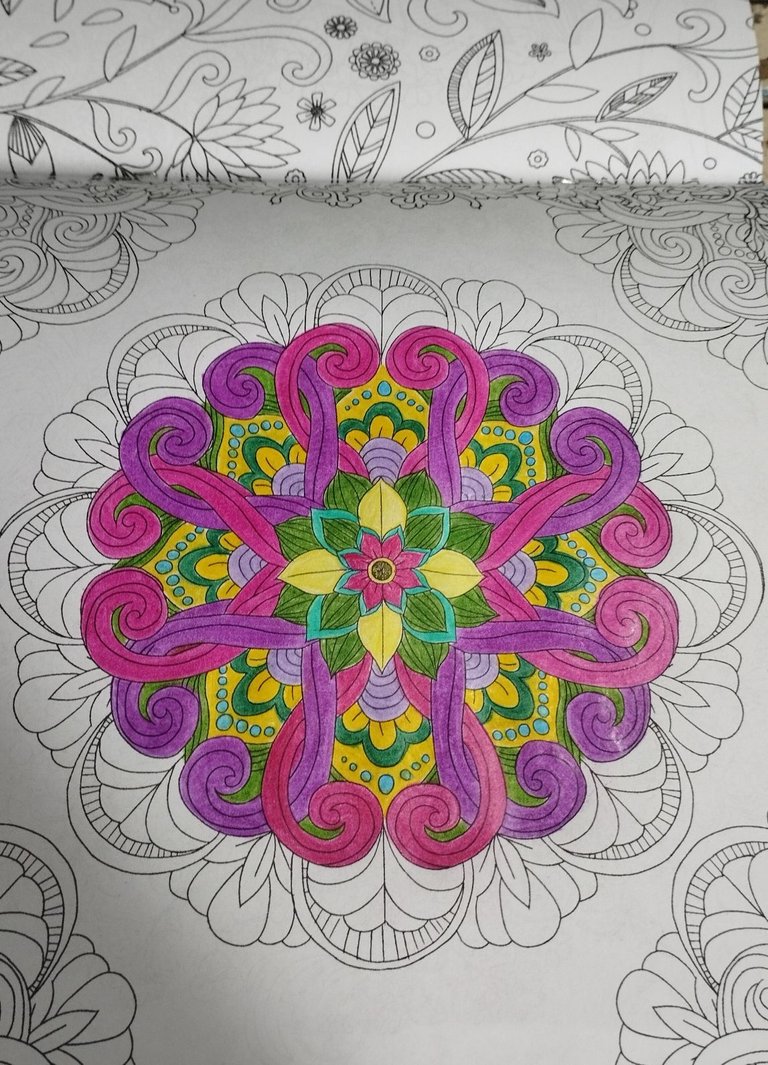
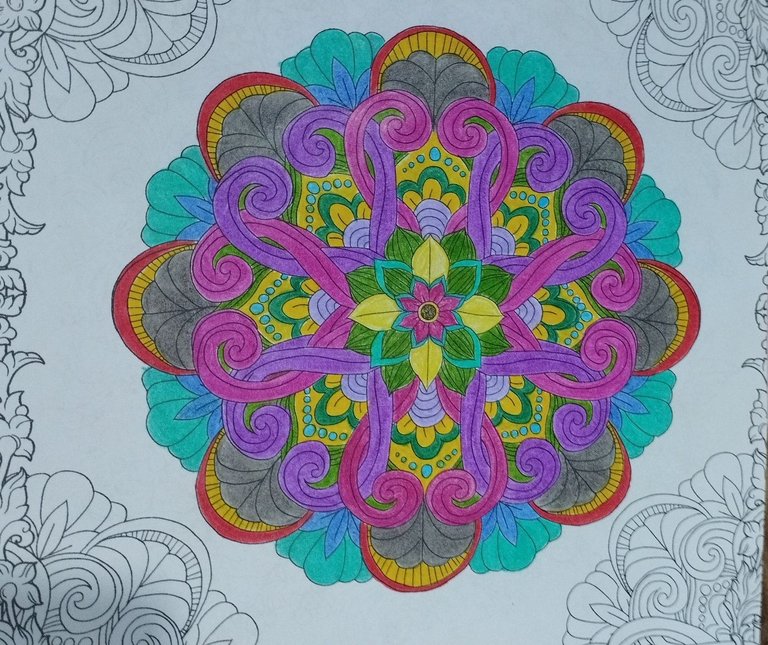
La información la investigue en las siguientes paginas:
The information is investigated on the following pages:
Un escrito muy nutritivo había muchas cosas que desconocía y gracias a tu publicación pude orientarme un poco.
Siempre me han encantado estos elementos. Saludos y muy bonito post